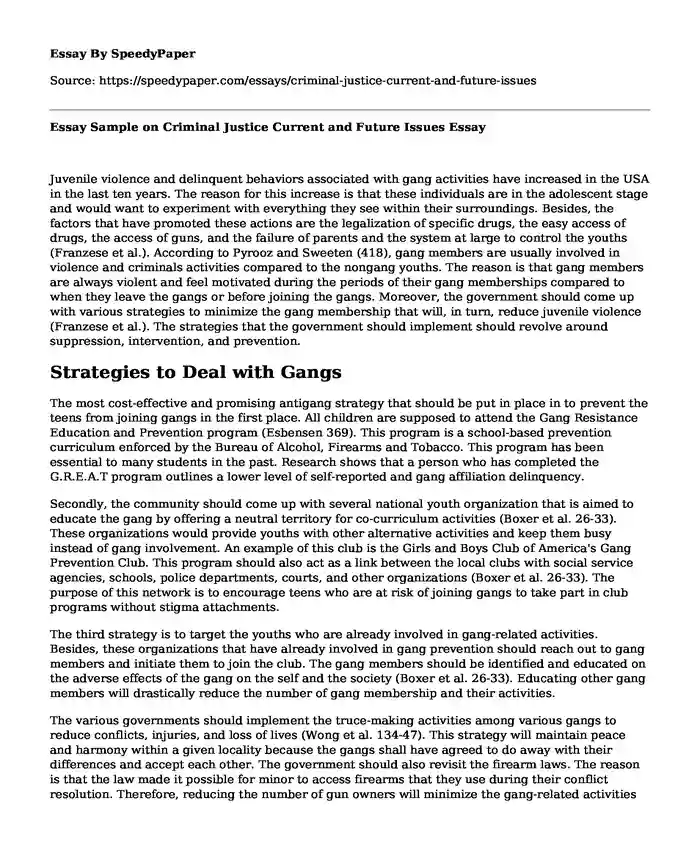
| Type of paper: | Essay |
| Categories: | Criminal justice Juvenile justice |
| Pages: | 3 |
| Wordcount: | 731 words |
Juvenile violence and delinquent behaviors associated with gang activities have increased in the USA in the last ten years. The reason for this increase is that these individuals are in the adolescent stage and would want to experiment with everything they see within their surroundings. Besides, the factors that have promoted these actions are the legalization of specific drugs, the easy access of drugs, the access of guns, and the failure of parents and the system at large to control the youths (Franzese et al.). According to Pyrooz and Sweeten (418), gang members are usually involved in violence and criminals activities compared to the nongang youths. The reason is that gang members are always violent and feel motivated during the periods of their gang memberships compared to when they leave the gangs or before joining the gangs. Moreover, the government should come up with various strategies to minimize the gang membership that will, in turn, reduce juvenile violence (Franzese et al.). The strategies that the government should implement should revolve around suppression, intervention, and prevention.
Strategies to Deal with Gangs
The most cost-effective and promising antigang strategy that should be put in place in to prevent the teens from joining gangs in the first place. All children are supposed to attend the Gang Resistance Education and Prevention program (Esbensen 369). This program is a school-based prevention curriculum enforced by the Bureau of Alcohol, Firearms and Tobacco. This program has been essential to many students in the past. Research shows that a person who has completed the G.R.E.A.T program outlines a lower level of self-reported and gang affiliation delinquency.
Secondly, the community should come up with several national youth organization that is aimed to educate the gang by offering a neutral territory for co-curriculum activities (Boxer et al. 26-33). These organizations would provide youths with other alternative activities and keep them busy instead of gang involvement. An example of this club is the Girls and Boys Club of America's Gang Prevention Club. This program should also act as a link between the local clubs with social service agencies, schools, police departments, courts, and other organizations (Boxer et al. 26-33). The purpose of this network is to encourage teens who are at risk of joining gangs to take part in club programs without stigma attachments.
The third strategy is to target the youths who are already involved in gang-related activities. Besides, these organizations that have already involved in gang prevention should reach out to gang members and initiate them to join the club. The gang members should be identified and educated on the adverse effects of the gang on the self and the society (Boxer et al. 26-33). Educating other gang members will drastically reduce the number of gang membership and their activities.
The various governments should implement the truce-making activities among various gangs to reduce conflicts, injuries, and loss of lives (Wong et al. 134-47). This strategy will maintain peace and harmony within a given locality because the gangs shall have agreed to do away with their differences and accept each other. The government should also revisit the firearm laws. The reason is that the law made it possible for minor to access firearms that they use during their conflict resolution. Therefore, reducing the number of gun owners will minimize the gang-related activities in the country.
Conclusion
The gang-related activities among the youths have been on the rise due to lack of education program that discourages youths from joining gangs, the firearm- ownership laws, and few clubs that would offer alternative programs to gang involvement. Nevertheless, the government should emphasize the need to adopt G.R.E.A.T programs in schools, the formation of clubs at a community level, truce-making activities, and revisiting its gun policies to prevent or deter gang-related activities.
Works Cited
Boxer, Paul, et al. "Gang involvement moderates the effectiveness of evidence-based intervention for justice-involved youth." Children and youth services review 52 (2015): 26-33.
Esbensen, FinnAage. "The Gang Resistance Education and Training (GREAT) Program." The Handbook of Gangs (2015): 369.
Franzese, Robert J., Herbert C. Covey, and Scott Menard. Youth gangs. Charles C Thomas Publisher, 2016.
Pyrooz, David C., and Gary Sweeten. "Gang membership between ages 5 and 17 years in the United States." Journal of Adolescent Health 56.4 (2015): 414-419.
Wong, Jennifer S., et al. "Promises kept? A meta-analysis of gang membership prevention programs." Journal of Criminological Research, Policy and Practice 2.2 (2016): 134-147.
Cite this page
Essay Sample on Criminal Justice Current and Future Issues. (2022, Jun 27). Retrieved from https://speedypaper.net/essays/criminal-justice-current-and-future-issues
Request Removal
If you are the original author of this essay and no longer wish to have it published on the SpeedyPaper website, please click below to request its removal:
- Financial Statement Analysis of the Company Red Bull. Free Essay.
- Free Essay on Fitting the Security Team into the Company Hierarchy
- Evaluating Leadership, Span of Control, and Outcomes in This Free Essay
- Essay Example in IT Project Management
- Free Essay about Budgetary Process
- Free Essay. Problem Identification Professional Product
- Essay Sample on A Feasibility Analysis of a Business
Popular categories




